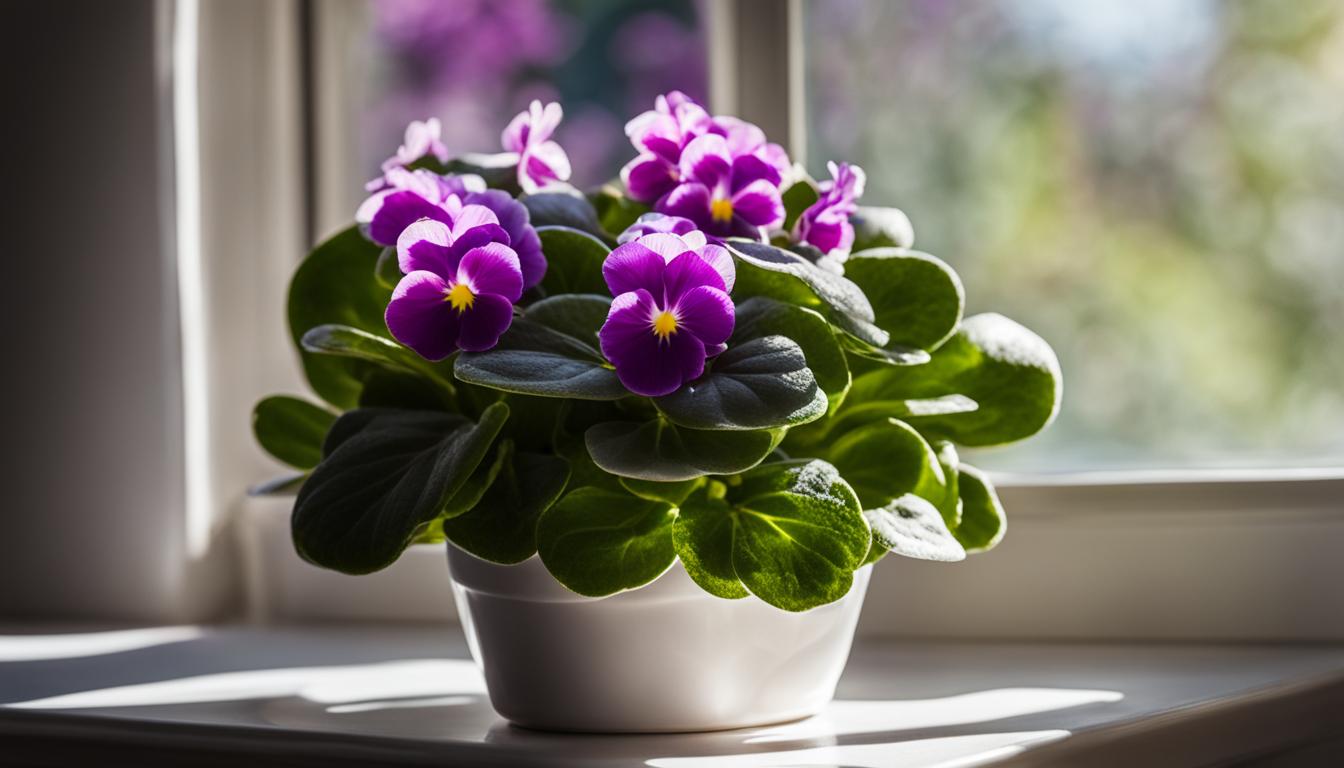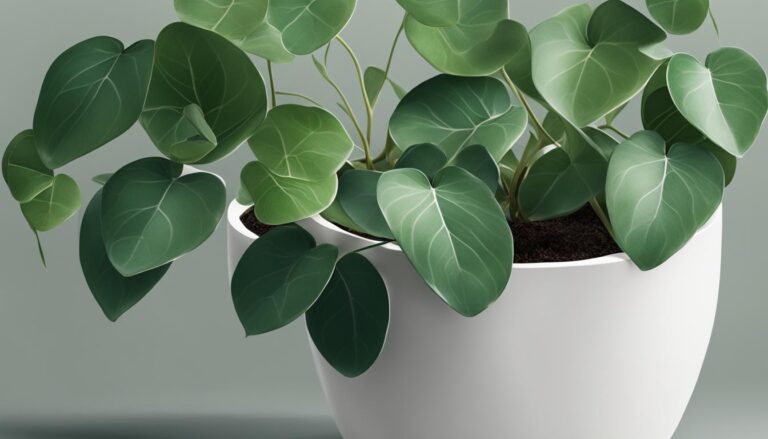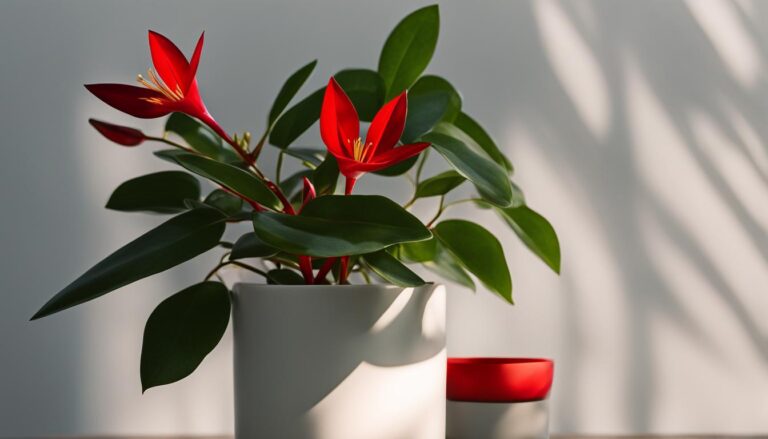
Welcome to my expert guide on growing African Violet (Saintpaulia) plants in your home. These popular houseplants require specialized care to thrive and showcase their beautiful blooms. In this section, I will share valuable tips and advice to help you successfully grow African Violets in your own space.
African violets, scientifically known as Saintpaulia ionantha, are known for their vibrant flowers and attractive foliage. To ensure their health and longevity, it’s important to provide them with the ideal growing conditions.
Firstly, African violets prefer bright, indirect light. Placing them near a sunny window or using artificial light can help them thrive.
When it comes to watering, it’s best to water at the soil level to avoid getting water on the leaves. African violets prefer moist, well-draining soil, so be mindful not to overwater.
Keeping the temperature between 60 to 80 degrees Fahrenheit is ideal for African violets. Avoid sudden temperature changes and drafts that can stress the plants.
Repotting should be done once a year using an all-purpose potting mix or African violet potting mix. This will provide the necessary nutrients for their growth.
Fertilizing with a quality African violet fertilizer every other week during the spring and summer seasons will enhance their overall health and encourage blooming.
Propagation of African violets can be done through leaf cuttings or offsets. Regular maintenance, such as removing suckers and dead leaves, is essential for their well-being.
With the right care and attention, African violets can live for many years, bringing beauty and elegance to your home. Stay tuned for more expert tips on caring for African violets in the upcoming sections.
African Violet Care: Troubleshooting Tips
When it comes to African violet care, it’s important to be aware of common issues that may arise. This section will provide you with expert tips to troubleshoot any problems you may encounter while caring for your African violets.
Lack of Blooms
If your African violets aren’t blooming, there could be a few reasons. Different cultivars have different blooming habits, so it’s possible that your variety simply doesn’t bloom as often as others. If you recently transplanted your African violet into a larger container, it may take some time for it to adjust and start producing blooms again.
Another factor to consider is light. Insufficient light exposure can hinder blooming, so make sure your African violets are getting the right amount of light, either from a sunny window or artificial light source.
Proper Watering Techniques
Watering is a crucial aspect of African violet care. It’s important to water at the soil level, avoiding water on the leaves. Overwatering can lead to root rot, while underwatering can cause the plant to wilt and the blooms to suffer. Finding the right balance is key.
African violets prefer a slightly moist soil, so make sure the soil is well-draining. Providing adequate humidity can also contribute to the health of your African violets.
Maintaining the Right Environment
Temperature and drafts can impact the well-being of your African violets. These plants thrive in temperatures between 60 to 80 degrees Fahrenheit, so avoid exposing them to extreme temperature fluctuations.
Drafts can also be harmful, so keep your African violets in a stable, draft-free environment. Another tip is to resist the urge to repot too frequently and avoid overfeeding your plants with fertilizer. Moderation is key when it comes to repotting and fertilizing African violets.
By addressing these common concerns and following these troubleshooting tips, you can ensure that your African violets thrive and showcase their beautiful blooms in your home.
The Beauty and Variety of African Violets
African violets, also known as Saintpaulia ionantha, are not only popular for their delicate beauty but also for the incredible variety they offer.
These exquisite houseplants exhibit a wide range of flower colors, leaf shapes, and plant sizes, making them a favorite among plant enthusiasts. This diversity is a result of natural mutations and hybridization, which have given rise to an array of captivating varieties.
When it comes to African violet varieties, the options are truly endless. They can boast single or double blossoms, each with its unique charm.
Some varieties showcase frilled edges, adding an extra touch of elegance to their blooms. Additionally, you can find African violets with flowers of different shapes, creating a visual spectacle that captivates the eye.
Among the most popular African violet varieties are ‘Persian Prince’, ‘Lyon’s Lavender Magic’, ‘Hawaiian Pearl’, ‘Summer Twilight’, ‘Lonestar Snowstorm’, and ‘Little Maya’.
These stunning cultivars are just a glimpse into the incredible range of choices available to collectors and enthusiasts. With such diversity, there is undoubtedly an African violet to suit every taste and preference.
Propagation is another fascinating aspect of African violets. These plants can be easily propagated through leaf cuttings or offsets.
Within a period of two to six months, new plantlets will form, ready to continue the legacy of their parent plants. It’s an exciting process that allows for the expansion of your African violet collection and the exploration of new varieties.
While African violets are undeniably beautiful, they do require proper care to thrive. Repotting and using the right potting mix are crucial for their health and growth.
It’s important to stay vigilant against common pests such as mealy bugs, aphids, and spider mites, as well as diseases like crown rot and root rot. By providing the right care and attention, you can ensure that your African violets will showcase their stunning blooms and bring joy to your home for years to come.
FAQ
How much light do African violets need?
African violets thrive in bright, indirect light. Place them near a sunny window, but avoid direct sunlight as it can damage the leaves.
How often should I water my African violets?
Water African violets at the soil level, keeping the leaves dry. Water when the top inch of soil feels dry, and be careful not to overwater as it can lead to root rot.
What type of soil should I use for African violets?
African violets prefer moist, well-draining soil. Use either an all-purpose potting mix or a specifically formulated African violet potting mix.
How often should I repot my African violets?
It is best to repot African violets once a year to provide them with fresh soil and room for growth. Use the same type of potting mix as mentioned earlier.
How often should I fertilize my African violets?
Fertilize African violets every other week with a quality African violet fertilizer during the spring and summer. Follow the instructions on the fertilizer packaging for the correct dosage.
How can I propagate African violets?
African violets can be propagated through leaf cuttings or offsets. Leaf cuttings can produce new plantlets within two to six months.
Why are my African violets not blooming?
There could be several reasons for lack of blooms, including different blooming habits among cultivars, recent transplanting into a larger container, insufficient light, or improper care and maintenance.
How do I address common African violet care concerns?
Troubleshooting tips include ensuring proper light exposure, avoiding overwatering and water on the leaves, maintaining the right temperature and humidity, and regular maintenance such as removing dead leaves and flowers. Also, be mindful not to overfeed with fertilizer.
What are some popular African violet varieties?
Some popular African violet varieties include ‘Persian Prince’, ‘Lyon’s Lavender Magic’, ‘Hawaiian Pearl’, ‘Summer Twilight’, ‘Lonestar Snowstorm’, and ‘Little Maya’.
What pests and diseases can African violets be susceptible to?
African violets can be susceptible to pests like mealy bugs, aphids, and spider mites, as well as diseases such as crown rot and root rot. Regular inspection and proper care can help prevent and address these issues.







2 Comments
Comments are closed.